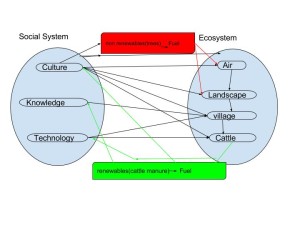The main idea behind my diagram is to show the social and ecosystem relationship between the renewable and nonrenewable resources used for biogas. It also shows the relationship the overall concept of the biogas system from the start of knowledge, culture and technology to the landscape, cattle, air and villages. The red lines display the negatives of using nonrenewable resources, trees. The reason that I put trees in the nonrenewable category is the villages use the trees for fuel. The need the wood from the trees to create a fire to cook etc. With the constant need for wood for fuel they are using the resources quicker than the trees can reproduce. This in turn causes a decrease in the population of trees in the ecosystem in the villages.
The diagram from “What is Human Ecology” and my diagram are similar in a way we showed the process of biogas from manure. The Big difference in mine and Marten’s was that his was a lot more advanced. I did not look into the science of the biogas, instead I chose to look at it from an environmental viewpoint. Marten’s diagram is a lot more technical and breaks it down even further than I did. He included the human population where I coupled it all together under culture. Something can be learned from mine that was not shown in his, the negatives of cutting the trees for fuel and the increase in knowledge and technology to create a better idea, turning manure into fuel.


Hi Tenaya, my name is Nick Gasparovich. I found your diagram very interesting, focusing on renewable and nonrenewable resources was a very intuitive way of looking at this task. I also took a very broad approach to looking at how all the components interacted with each other. Your post made me realize that sustainability is somewhat related to feedback loop, the best example is your analysis of using trees for cooking fuel. I agree on your analysis of Marten’s diagram, it was very detailed into the fundamental science of biogas generators while both of us looked at the generator as a environmental component. Take a look at my blog –http://geog030.dutton.psu.edu/2016/01/24/nick-gasparovich-module-2-learning-task/
Hi Tenaya! My name is Amanda and here is a link to my blog: http://geog030.dutton.psu.edu/2016/01/23/biogas-amanda-giedroc/
I thought your diagram was great! I found it interesting because you incorporated the idea of culture, knowledge and technology into the social system. It never occurred to me that the people within the town would have a growth of knowledge by using the generators on how to make fuel. Additionally, I never gave much thought to how culture could be transformed for by a generator. My diagram is much more focused on the process leading up to the usage of the biogas generators.
Hi Tenaya! I liked how you took the more broad approach to the topics. As I discussed in my blog:
http://geog030.dutton.psu.edu/2016/01/23/biogas-diagram-john-windt/
there are two approaches to the diagram. There is a more specific approach like mine and a generalized approach like yours and Marten’s diagrams. It was very interesting how you used the arrows only for resources!